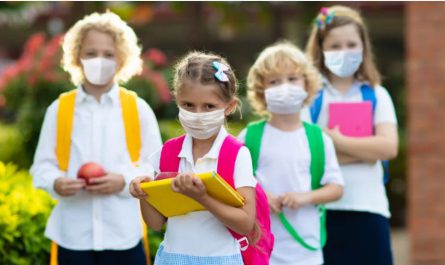In the aftermath of the COVID-19 pandemic, the public is being briefed about the physical effects of the disease and actions to be taken to prevent exposure to the novel Coronavirus and manage symptoms when diagnosed. However, the effects of this pandemic with regard to one’s mental health have not been studied at length and need further investigation. As all efforts are centered on understanding the epidemiology, clinical symptoms and management of the COVID‐19 outbreak, there is a paucity of data on its effects on one’s mental health, especially in children and adolescents.
Children and adolescents were adversely affected by the unexpected changes in daily routine and social interaction — the sudden discontinuance of school, social life and outdoor activities. Some of them also experienced an increase in domestic violence. According to the United Nations Children’s Emergency Fund (UNICEF), the nationwide closure of schools and colleges have negatively impacted over 91% of the world’s student population.
Psychosocial factors and mental health of children
According to UNESCO, the worldwide closures of schools and colleges have negatively impacted over 91% of the world’s student population. Amid COVID-19 and stay-at-home orders, people around the world have experienced a sense of fear and anxiety. This pandemic has created both short-term and long-term psychosocial and mental health complications for children and adolescents. The nature and intensity of impact on minors is subjected to many factors like age, grade, pre-existing mental health condition, financial status or being quarantined due to infection or fear of the spread of infection.
The stress they experience directly affects their mental health on account of increased anxiety, changes in eating habits and in school dynamics.
Impact on children’s mental health
The pandemic and the lockdowns have adversely impacted children and adolescents’ emotional and social development when compared to adults. In one of the preliminary studies published by Lancet Child and Adolescent Health, it was found that younger children were more likely to manifest symptoms such as clinginess and fear of family members getting infected, whereas the older children were more susceptible to experience inattention and were persistently inquiring about COVID-19. In addition to the above, acute psychological conditions of increased inattention, irritability and clinging behaviour were revealed by all children, irrespective of their age groups. Based on the questionnaires completed by the parents, the results reveal that children felt uncertain, fearful and isolated and also experienced poor appetite, agitation, nightmares, disturbed sleep, inattention and suffered from separation anxiety.
Psychological Well-being:
The home quarantine of children and adolescents is associated with anxiety and unpredictability, which is attributed to a disruption in their education, physical activities and opportunities for socialization. Disruption of routine and absence of structured setting of the school for a long duration result in boredom and lack of motivation for engaging in various academic and extracurricular activities. Children who are not able to play outdoors, meet friends or engage in in-person school activities are prone to become more attention-seeking, clingy and more dependent on their parents due to changes in their routine. The restrictions imposed due to such measures on children can have a long term negative effect on their overall psychological wellbeing.
Mental health disorders
According to a study published in the BMC Pediatrics journal, 20.7% and 7.2% of children reported experiencing post-traumatic stress disorder (PTSD) and depressive symptoms, respectively, due to the COVID-19 pandemic. The scores were significantly higher among middle school and boarding school students compared to primary and day school students. They found one in five children have PTSD and one in 14 children have depressive symptoms.
Violence and Abuse
Further, prolonged home quarantine, children’s compulsive use of the Internet and social media may expose them to age-restricted content and also increase their vulnerability to get bullied or abused. To make matters even worse, as schools, legal and preventative services are not fully functional during lockdowns, children are rarely in a position to report any untoward incident if they are subjected to abuse, violence and harm while at home.
Impact on children and adolescents having special needs during mental health problems
According to the CDC, there are about one in every six children within the age group of 2-8 years who have some or the other neurodevelopmental, behavioral or emotional difficulty. During the pandemic, children with special needs [autism, attention deficit hyperactivity disorder, cerebral palsy, learning disability, developmental delays and other behavioral and emotional difficulties] encounter challenges that are different from what a typical child faces. They may show intolerance when faced with uncertainty and aggravation in the symptoms due to the enforced restrictions and unfavorable environment which does not correspond with their regular routine. Along with difficulties in following instructions, understanding the complexity of the pandemic and doing their own work independently, they seem to be the ones that are neglected the most.
With the closure of special schools and daycare centres, these children could regress or relapse with a lack of access to resource material, peer group interactions and opportunities of learning and developing important social and behavioural skills.
Aiding children with intervention programs
Intervention programs to serve children and caregivers in these times should be made and implemented by local government agencies.
For parents, programs should focus on educating to recognize and respond to the children’s fears and worries effectively, The main role and responsibility of parents is to provide and nurture a safe, secure and healthy environment where the children can be themselves and develop to their full potential. The stress associated with the pandemic is enhanced when they are not allowed to go out, meet their friends, attend school and more so while the parents are themselves stressed and display it.
For children, programs should focus on engaging them in a cognitively stimulating environment.
- Skill-building opportunities to focus & self-control. Perspective taking. Communicating. Making connections. Critical thinking and engaged learning.
Particularly, while it is important to keep children safe and make them feel loved, it is equally important to listen, understand and reassure them. Parents should closely monitor children for any signs of change in behavior and sensitively apprise them of the situation.
Parents should also spend quality time with them, establish and regularize their daily schedule, do fun activities together to take their minds off the crisis, engage and encourage them to do physical activity, and help them in their hobbies. Children may need extra love and attention. The future of the world depends on how strong and resilient we raise our next generation to be.
With @school, it is now possible to not just screen children for different disorders, but also help them with our wide range of compiled articles and videos to navigate through any difficult situation or challenges. It also comes with remedial and preventive measures that could be useful in different situations. @school is a handy tool for students, to learn more about it check out our website.




